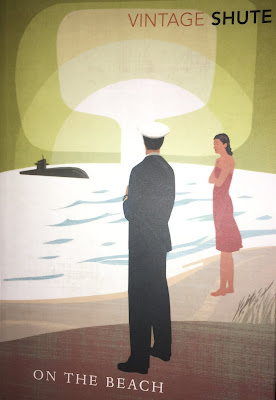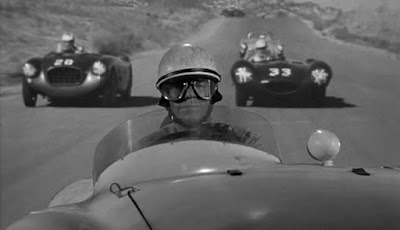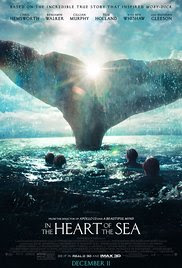"On the Beach is a 1959 American post-apocalyptic science fiction drama film from United Artists, produced and directed by Stanley Kramer, that stars Gregory Peck, Ava Gardner, Fred Astaire, and Anthony Perkins.
This black-and-white film is based on Nevil Shute's 1957 novel of the same name depicting the aftermath of a nuclear war.
Unlike the novel, no blame is placed on whoever started the war; it is hinted in the film that the threat of annihilation may have arisen from an accident or misjudgment."
"In early 1964, in the months following World War III, the conflict has devastated the Northern Hemisphere, polluting the atmosphere with nuclear fallout, killing all life there.
Air currents are slowly carrying the fallout south; the only areas still habitable are in the far reaches of the Southern Hemisphere.
From Australia, survivors detect an incomprehensible Morse code signal coming from the West Coast of the United States.
From Australia, survivors detect an incomprehensible Morse code signal coming from the West Coast of the United States.
The American nuclear submarine, USS Sawfish, now under Royal Australian Navy command, is ordered to sail north to the United States to attempt to make contact with the sender of the Morse signal.
The submarine is commanded by Capt. Dwight Towers (Gregory Peck), who must leave his new friend, the alcoholic Moira Davidson (Ava Gardner).
The Australian government arranges for its citizens to receive suicide pills or prepared injections so they may end things quickly before there is prolonged suffering from radiation sickness.
The Australian government arranges for its citizens to receive suicide pills or prepared injections so they may end things quickly before there is prolonged suffering from radiation sickness.
An Australian naval officer, Peter Holmes (Anthony Perkins) and his wife, Mary, who is in denial about the impending disaster, have a baby daughter.
Assigned to travel with the American sub for several weeks, Peter tries to explain to Mary how to euthanize their baby and then kill herself should he not be home yet when the end comes; Mary reacts very emotionally to this prospect.
One scientist's theory is that the radiation level near the Arctic Ocean could be lower than that found at the mid-Northern Hemisphere, possibly indicating that the radiation could disperse before reaching the Southern Hemisphere.
One scientist's theory is that the radiation level near the Arctic Ocean could be lower than that found at the mid-Northern Hemisphere, possibly indicating that the radiation could disperse before reaching the Southern Hemisphere.
This theory is to be explored as part of the submarine's main mission.
After sailing to Point Barrow, Alaska, they find that radiation levels are, in fact, intensifying."
"The movie was filmed in 1959.
For one year (July 4, 1959 - July 4, 1960) the US flag had 49 stars.
In the opening scene a 49-star flag can be seen flying from the submarine."
"Nevil Shute was displeased with the final cut of the film, feeling that too many changes had been made at the expense of the story's integrity.
"The U.S. Department of Defense and the United States Navy declined to cooperate in the production of this film, including access to a nuclear-powered submarine, which forced the film production to use a non-nuclear, diesel-electric Royal Navy submarine, HMS Andrew (Royal Navy submarines were based in Australia until 1967, when the Royal Australian Navy commissioned its own submarines)."
In the novel the submarine is named USS Scorpion, but in the film, it is called Sawfish.
Being a nuclear-powered submarine I think the USS Scorpion would have made more sense as a name, because the sting would have been in the sub's tail, so to speak, with nuclear weapons having destroyed the world.
The aircraft carrier near the beginning of the movie is the HMAS Melbourne.
It was laid down on the anniversary of the sinking of the Titanic (April 15th).
"HMAS Melbourne never fired a shot in anger during her career, having only peripheral, non-combat roles in relation to the Indonesia-Malaysia confrontation and the Vietnam War.
She was, however, involved in two major collisions with allied vessels.
The first occurred on the evening of 10 February 1964, in which Melbourne rammed and sank the RAN destroyer HMAS Voyager when the latter altered course across her bow.
Eighty-two of Voyager's personnel were killed, and two Royal Commissions were held to investigate the incident.
The second collision occurred in the early morning of 3 June 1969, when Melbourne also rammed the United States Navy (USN) destroyer USS Frank E. Evans in similar circumstances.
Seventy-four American personnel died, and a joint USN–RAN Board of Inquiry was held.
These incidents, along with several minor collisions, shipboard accidents, and aircraft losses, led to the reputation that Melbourne was jinxed."
"The three leading men --Gregory Peck, Fred Astaire, and Anthony Perkins-- had all previously been leading men opposite Audrey Hepburn in Roman Holiday (1953), Funny Face (1957), and
Green Mansions (1959), respectively.
"After a lifetime of smoking, Ava Gardner suffered from emphysema, as well as an unidentified auto-immune disorder.
 |
| Not a very good screenshot from my iPad of 'On the Beach' |
 |
| When I was at IMDB there was this HT3 "on the beach" scene:-) |
For one year (July 4, 1959 - July 4, 1960) the US flag had 49 stars.
In the opening scene a 49-star flag can be seen flying from the submarine."
After initial collaboration with Kramer, it was obvious that Shute's concerns were not being addressed; subsequently, he provided minimal assistance to the production.
Gregory Peck agreed with Shute but, in the end, producer/director Stanley Kramer's ideas won out. Shute felt that Captain Towers and Moira having a love affair ruined a central element of the novel, that is, Towers's fidelity to his long-dead American wife."
Nevil Shute died in Melbourne in 1960 after a stroke, some suggesting brought about by his hatred of the film version of his book.
 |
| Another poor screenshot from my iPad of 'On the Beach' |
In the novel the submarine is named USS Scorpion, but in the film, it is called Sawfish.
Being a nuclear-powered submarine I think the USS Scorpion would have made more sense as a name, because the sting would have been in the sub's tail, so to speak, with nuclear weapons having destroyed the world.
The aircraft carrier near the beginning of the movie is the HMAS Melbourne.
It was laid down on the anniversary of the sinking of the Titanic (April 15th).
 |
| 'On the Beach' was filmed in 1959, but took place in 1964 |
She was, however, involved in two major collisions with allied vessels.
The first occurred on the evening of 10 February 1964, in which Melbourne rammed and sank the RAN destroyer HMAS Voyager when the latter altered course across her bow.
Eighty-two of Voyager's personnel were killed, and two Royal Commissions were held to investigate the incident.
The second collision occurred in the early morning of 3 June 1969, when Melbourne also rammed the United States Navy (USN) destroyer USS Frank E. Evans in similar circumstances.
Seventy-four American personnel died, and a joint USN–RAN Board of Inquiry was held.
These incidents, along with several minor collisions, shipboard accidents, and aircraft losses, led to the reputation that Melbourne was jinxed."
"The three leading men --Gregory Peck, Fred Astaire, and Anthony Perkins-- had all previously been leading men opposite Audrey Hepburn in Roman Holiday (1953), Funny Face (1957), and
Green Mansions (1959), respectively.
A signed photo of the three men on the set of On the Beach was sold at Christie's auction house as part of the Audrey Hepburn: The Personal Collection in October 2017."
"Diagnosed with HIV during the filming of Psycho IV: The Beginning, Perkins died at his Los Angeles home on September 12, 1992, from AIDS-related pneumonia at age 60.
"Diagnosed with HIV during the filming of Psycho IV: The Beginning, Perkins died at his Los Angeles home on September 12, 1992, from AIDS-related pneumonia at age 60.
His urn, inscribed "Don’t Fence Me In," is in an altar by a bench on the terrace of his former home in the Hollywood Hills.
 |
| The Twin Towers?! |
 |
| Peck as Cmdr. Dwight Lionel Towers?! |
 |
| Fred Astaire as Julian Osborn in 'On the Beach' |
In the novel the character played by Fred Astaire in the movie drives his racing car in Bourke Street -
"John Osborne's Ferrari on the road did not call for any action from the police, even when his foot slipped upon the unfamiliar accelerator on his first drive and he touched eighty-five in second gear in Bourke Street, in the middle of the city.
Unless he were to kill anybody, the police were not disposed to prosecute him for a trifle such as that.
He did not kill anybody, but he frightened himself very much."
Page 160 of 'On the Beach'.
"In the January 2017 Melbourne car attack, a person on the run from police deliberately drove their car onto the footpath and ran over innocent bystanders at Bourke Street Mall.
"John Osborne's Ferrari on the road did not call for any action from the police, even when his foot slipped upon the unfamiliar accelerator on his first drive and he touched eighty-five in second gear in Bourke Street, in the middle of the city.
Unless he were to kill anybody, the police were not disposed to prosecute him for a trifle such as that.
He did not kill anybody, but he frightened himself very much."
Page 160 of 'On the Beach'.
 |
| Police car #64? |
 |
| January, 1964? |
The attack claimed the lives of six people, including one baby and one child.
Over twenty-five victims were hospitalised with injuries."
In the novel the guy who gets sent ashore to investigate the mysterious Morse code discovers a packet of Lucky Strike cigarettes -
"He glanced again at the carton of Lucky Strikes, but the captain was right, of course; they would be hot and it might well be death to smoke them.
"He glanced again at the carton of Lucky Strikes, but the captain was right, of course; they would be hot and it might well be death to smoke them.
He left them with regret and went downstairs."
Page 194 of 'On the Beach'.
We know now that cigarettes will kill you in the long run anyway.
 |
| Ava Gardner |
Two strokes in 1986 left her partially paralyzed and bedridden."
I guess there were rumours that smoking could kill you back then, but denial is a bit like sticking your head in the sand 'On the Beach' and hoping those rumours are just rumours and nothing more, while you carry on doing what will kill you in the end.
I guess there were rumours that smoking could kill you back then, but denial is a bit like sticking your head in the sand 'On the Beach' and hoping those rumours are just rumours and nothing more, while you carry on doing what will kill you in the end.
'On the Beach', Not Being Able to See the Forest for the Trees and Permaculture?
I also find it interesting that Gregory Peck played Captain Ahab in the 1956 movie 'Moby Dick', but that's the subject of another post.
I also find it interesting that Gregory Peck played Captain Ahab in the 1956 movie 'Moby Dick', but that's the subject of another post.
"During the 1980s Gregory Peck was a very active opponent of President Ronald Reagan's Star Wars defense missile system.
Peck stated his main priority in life was to see the world rid of nuclear weapons."
As old as the movie and book of 'On the Beach' are, they have never been more relevant to the present world situation as far as nuclear war goes.
Plus, ironically in the story of 'On the Beach' the culprit that is being blamed on climate change today (petrol) has nearly run out and other forms of transport have to be considered.
Back in the late fifties such ideas as climate change were the last thing on the world's mind.
As we race ahead to the future, I guess we have to ask ourselves, are we too living in denial like a lot of the characters in the story who on the one hand know the world is coming to an end through mankind's ignorance, but on the other hand keep denying that it is.
Peck stated his main priority in life was to see the world rid of nuclear weapons."
 |
| 30th Anniversary of the $2 Coin |
Plus, ironically in the story of 'On the Beach' the culprit that is being blamed on climate change today (petrol) has nearly run out and other forms of transport have to be considered.
Back in the late fifties such ideas as climate change were the last thing on the world's mind.
As we race ahead to the future, I guess we have to ask ourselves, are we too living in denial like a lot of the characters in the story who on the one hand know the world is coming to an end through mankind's ignorance, but on the other hand keep denying that it is.

























Fascinating! Eager to read the rest!
ReplyDelete